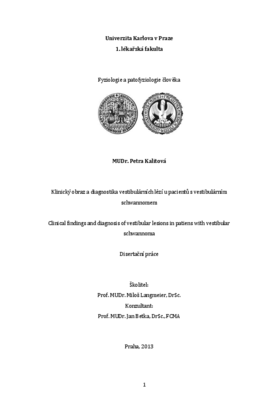Klinický obraz a diagnostika vestibulárních lézí u pacientů s vestibulárním schwannomem
Clinical findings and diagnosis of vestibular lesions in patiens with vestibular schwannomem
dizertační práce (OBHÁJENO)

Zobrazit/
Trvalý odkaz
http://hdl.handle.net/20.500.11956/53315Identifikátory
SIS: 136000
Kolekce
- Kvalifikační práce [4588]
Autor
Vedoucí práce
Oponent práce
Šlapák, Ivo
Kozler, Petr
Fakulta / součást
1. lékařská fakulta
Obor
-
Katedra / ústav / klinika
Fyziologický ústav 1. LF UK v Praze
Datum obhajoby
19. 9. 2013
Nakladatel
Univerzita Karlova, 1. lékařská fakultaJazyk
Čeština
Známka
Prospěl/a
Klíčová slova (česky)
vestibulární schwannom, elektronystagmografie, posturografie, posturální stabilita, vestibulární rehabilitace, vizuální zpětná vazbaKlíčová slova (anglicky)
vestibular schwannoma, electronystagmography, posturography, postural stability, vestibular rehabilitation, visual feedbackPráce je věnována diagnostice a následné rehabilitaci vestibulárního postižení u pacientů s vestibulárním schwannomem. V první části jsme se soustředili na analýzu souboru pacientů před plánovanou resekcí vestibulárního schwannomu, zejména na zhodnocení přínosu posturografického vyšetření a na optimalizaci vyšetřovacího algoritmu vestibulárního postižení. Ve druhé části nás zajímalo, zda rehabilitace posturální stability po resekci vestibulárního schwannomu doplněná o vizuální zpětnou vazbu urychlí vestibulární kompenzaci. Soubor obsahuje celkem 44 pacientů, kteří podstoupili resekci vestibulárního schwannomu. U pacientů bylo předoperačně provedeno základní vestibulární vyšetření, elektronystagmografie a posturografie. Ve druhé části práce bylo z výše zmíněného souboru vybráno 17 pacientů, kteří byli zařazeni do skupiny rehabilitace a rehabilitace s biofeedbackem. Pro zhodnocení jednotlivých parametrů souboru byl použit t-test pro dva nezávislé výběry a kontingenční tabulka. Velké množství proměnných bylo redukováno pomocí faktorové analýzy. V rámci hodnocení výsledků rehabilitace byl pro statistickou analýzu použit neparametrický Wilcoxonův jedno-výběrový test. Z výsledků vyplývá, že nejtypičtějším parametrem pro vestibulární postižení je čas otočky, který je vyšetřován v rámci posturografie....
Summary: The aim of our study was diagnosis and rehabilitation of vestibular loss in patients with vestibular schwannoma. In the first part we focused on analysis of a group of patients before resection of vestibular schwannoma, mainly on evaluation of gain of posturography and on optimalisation of diagnostic algorithm of vestibular pathology. Throughout the second experiment, we studied if rehabilitation of postural gait with visual biofeedback will speed up vestibular compensation in patients after resection of vestibular schwannoma. The group consisted of 44 patients, who underwent surgical removal of vestibular schwannoma. Before surgery each patient underwent clinical vestibular examination, electronystagmographic recordings and posturography. In the second part of the study 17 patients from previous group were chosen. These patients underwent rehabilitation and rehabilitation with biofeedback. For evaluation was used independent samples T-test and cross-tabulation. A great number of variables were reduced by factor analysis. For statistical analysis of the group with rehabilitation was used nonparametric Wilcoxon signed rank test. Statistical analysis revealed that the most typical parameter for vestibular pathology is the time of the step quick turn test, which is a part of posturography. We proved...
